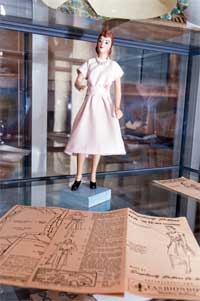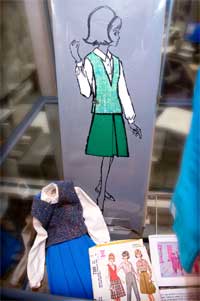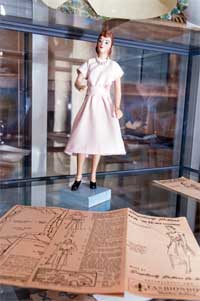 Dolls latest donation to URI’s Commercial Pattern Archive
Dolls latest donation to URI’s Commercial Pattern Archive
KINGSTON, R.I.–July 13, 2010—Fashion “dolls” dressed in clothes created from McCall’s and Simplicity patterns are on exhibit in the display cases on the first and second floor of the University of Rhode Island’s Robert L. Carothers Library and Learning Commons, 15 Lippitt Road, Kingston. The exhibit, free and open to the public, runs through August during library hours.
Not designed as toys, fashion ”dolls” were used to create excitement for home sewing by showcasing pattern designs and fashions.
The Building Blocks of Fashion exhibit also features promotional display boards and fashion patterns from the 1920s through the 1960s. The boards feature a transparency, which gave consumers the opportunity to see previews of how the completed project would look in different materials.
Professor Emerita of Theater Joy Spanabel Emery, who is also a former adjunct professor of textiles, fashion merchandising and design curated the exhibit with associate professor Sarina Rodrigues Wyant.
Most of the displayed items come from the Elizabeth Brown Collection that was recently donated to URI’s Commercial Pattern Archive. Brown worked as a representative of McCall Pattern Company throughout the 1960s. She took many of the pieces to department stores to demonstrate the fashions of the latest McCall’s patterns and to attract consumer interest in home sewing.
 Margit Nilsen, a leading manufacturer of store window mannequins circa 1939/1940, designed the larger dolls, dubbed minikins. They were featured displays in dry goods sections to show the pattern style and suggested fabrics.
Margit Nilsen, a leading manufacturer of store window mannequins circa 1939/1940, designed the larger dolls, dubbed minikins. They were featured displays in dry goods sections to show the pattern style and suggested fabrics.
Brown also collected from other pattern companies including Simplicity’s “FashionDol” which are also on exhibit.
“She is an avid collector,” said Emery who has known Brown for years and collaborated with her on a Fashion Institute of Technology (FIT) commercial patterns exhibit in 1997.
Now 90, Brown, a resident of Bellmead, New Jersey, sought a “home” for her collection.
“URI can provide that home,” said Emery who curates the pattern archive. Designated an official project of Save America’s Treasures by the National Trust for Historic Preservation, the URI Commercial Patten archive, located in the library’s Special Collections Unit, contains the largest pattern collection in the world.
While most of the doll clothing on display is original, Roberta Hale of Wickford created some reproduction clothing from patterns in the archive.
The archive continues to grow. About 2,500 patterns are donated annually. Donations prior to 1960 are always welcomed.
“I’m always looking for Pictorial Review patterns, which were popular during the 1920s,” said Emery. “They used lovely photography, created beautiful pieces with a real quality of style and provided clear instructions.”
URI’s Commercial Pattern Archive online database contains more than 50,000 scanned images, which provides a unique tool for researchers and designers to recreate or date clothing from 1868 to 2000. To subscribe, visit http://www.uri.edu/library/special_collections/COPA/
If you have specific questions, contact Emery at 401.874.2713 or jemery@uri.edu.
Pictured above
Simplicity “doll” wears an original dress created from a pattern.
ON DISPLAY: A promotional display board previews how a pattern would look in a particular fabric. Roberta Hale of Wickford created clothing for the “doll” in a different fabric using the same pattern. URI photos by Michael Salerno

